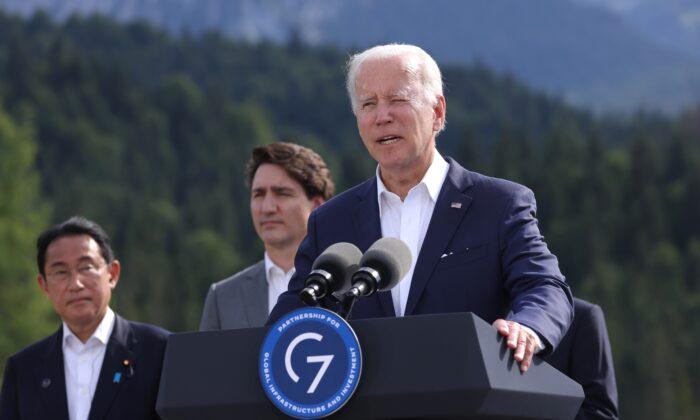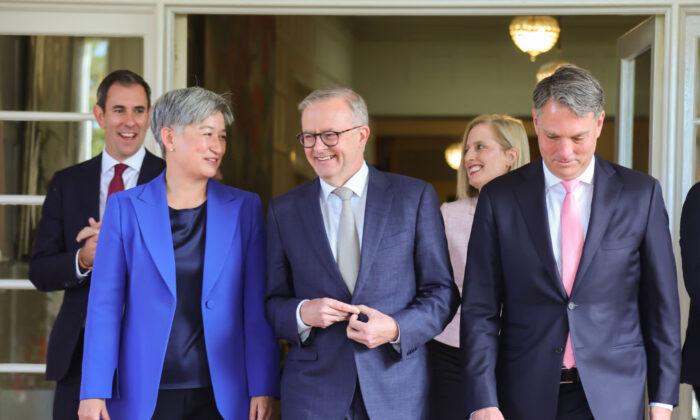A new post-centrist style of politics is emerging worldwide as the political centre weakens and voters shift both right and left.
The same has been happening in Australia as ever-more voters lose faith in the legacy two-party system—destabilising the old way of doing politics.
The current Australian federal election illustrates how disruptive the shift from the centre has been; it also shows how some politicians have learned quicker than others how to play the new game.
Although Australian politics may be more insulated from the upheavals in the United States, United Kingdom, and Europe, some broad patterns can still be observed. Both legacy political parties—the traditionally centre-right Coalition and centre-left Australian Labor Party (ALP)—together only attract around 50 percent of the voters.
Recent polls suggest around 34 percent of voters support the ALP, 33 percent support the Coalition, and 33 percent support one of the minor parties. So a one-third, one-third, and one-third split.
And that’s the pattern we see playing out across the world in today’s post-centrist (post-globalization) political landscape—as major parties bleed away support to a plethora of new minor parties or entrants on both sides of the spectrum.
Thus, in Australia, we see the left-wing Greens Party now enjoying 15 percent of voter support (with much of this taken from the ALP). While both the United Australia Party and right-wing One Nation Party attract four percent each.
For the old mainstream parties, the job of winning government-of-the-day has become much harder. This also spells trouble for the two-party political system that has become a revolving door of power between the centre-right and centre-left parties.

However, Australia’s compulsory voting and preferential voting system has managed to help artificially prop up the two political parties (at least for now).
In other countries, disgruntled voters would simply not turn up on voting day. While those hoping to vote for an alternate party end up having their vote transferred to the incumbent Coalition and ALP because of the preferential system.
What the Australian system does is reward those who can best strategise and leverage the preferential system and growing discontent with the establishment—at the moment, that appears to be the left.
We can see billionaire Simon Holmes à Court’s Climate 200 “teal independents” organise an effective assault on the Coalition.
Holmes à Court has stirred up rebellion by progressive voters within the Liberal Party by saying the prime minister has moved the Coalition too far to the right.
His Climate 200 group is gaming the system seat-by-seat such that by combining the preferences of the ALP and Greens with the “teal independents,” the Coalition now looks set to lose enough inner-city seats to make it impossible for them to form government.
Possible results include an ALP-minority government beholden to the Greens or a Coalition minority government beholden to Holmes à Court’s “teal independents.” Either way, Australia moves leftwards and greenwards.
But if Holmes à Court has learned how to manipulate the politics of post-centrist disgruntlement successfully, the same cannot be said for the right-leaning micro-parties. Unfortunately, it seems that no one on the right has learned how to play the new politics of disgruntlement successfully.

Indeed, for Aussie conservatives, the poor strategising and campaigning of the right can be depressing.
At the moment, disgruntled right-leaning voters have been dispersed across a range of minor parties whose capacity to make any real impact on the broader direction of Australian politics is limited.
The oldest—and most well-known—of the right is One Nation. This party has long had the potential to recruit socially conservative workers out of the ALP. Yet even with this rising tide of disgruntlement, One Nation has seen limited growth. With more creative strategic thinking—and stronger management—the party should at least have become as large as the Greens, giving One Nation the muscle to pull the incumbent Coalition towards the right.
Then we have the Clive Palmer-backed United Australia Party spending $70 million (US$50 million) on marketing and advertising to attract just four percent of voters.
This huge amount of money—if well spent—should have delivered a boost to the influence of conservative values upon Australian politics. But again, we have a less than satisfactory performance, with millions being spent to simply weaken the centre-right in ways that only serve to strengthen the centre-left and Greens.
For Australian conservatives, this is an unhelpful lose-lose situation.
As for the Liberal Democrats, despite having a well-managed campaign, they lack the funding to be able to punch through the clutter and get them in the game.
The only hope for these parties is to attract disgruntled suburban and regional voters still upset over the pain of the COVID-19 lockdowns.
Overall, it remains to be seen how the last two weeks of the 2022 election period will play out and whether it can deliver a good outcome for conservatives, despite the weak front presented by its political parties.





